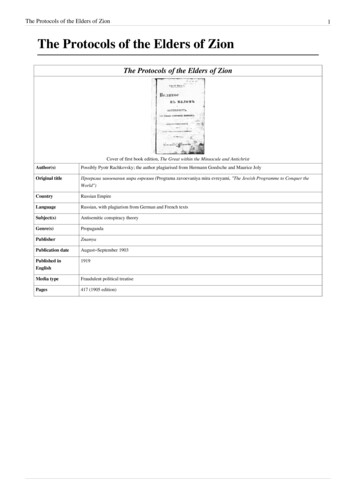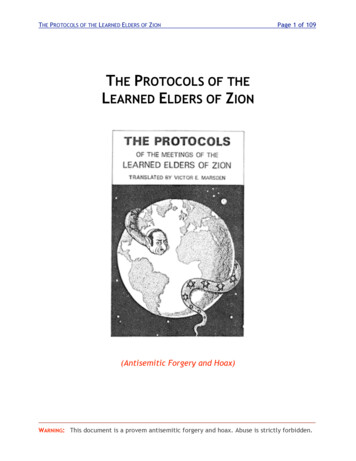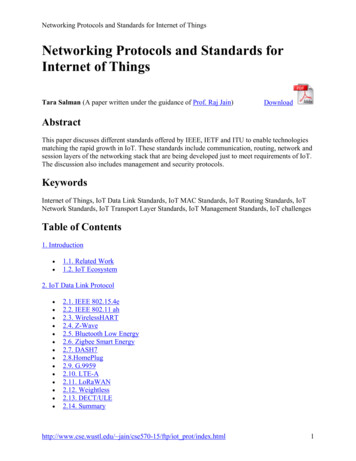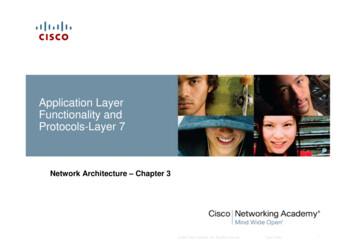
Transcription
The Protocols of the Elders of Zion1The Protocols of the Elders of ZionThe Protocols of the Elders of ZionCover of first book edition, The Great within the Minuscule and AntichristAuthor(s)Possibly Pyotr Rachkovsky; the author plagiarised from Hermann Goedsche and Maurice JolyOriginal titleПрограма завоевания мира евреями (Programa zavoevaniya mira evreyami, "The Jewish Programme to Conquer theWorld")CountryRussian EmpireLanguageRussian, with plagiarism from German and French textsSubject(s)Antisemitic conspiracy theoryGenre(s)PropagandaPublisherZnamyaPublication dateAugust–September 1903Published inEnglish1919Media typeFraudulent political treatisePages417 (1905 edition)
The Protocols of the Elders of Zion2A reproduction of the 1905 Russian edition bySerge Nilus, appearing in PraemonitusPraemunitus (1920).Part of a series onAntisemitismPart of Jewish history HistoryTimelineResourcesCategoryThe Protocols of the Elders of Zion or The Protocols of the Meetings of the Learned Elders of Zion is anantisemitic hoax purporting to describe a Jewish plan for global domination. It was first published in Russia in 1903,translated into multiple languages, and disseminated internationally in the early part of the 20th century. Henry Fordfunded printing of 500,000 copies that were distributed throughout the US in the 1920s.Adolf Hitler and the Nazis publicized the text as if it were a valid document, although it had already been exposed asfraudulent. After the Nazi Party came to power in 1933, it ordered the text to be studied in German classrooms. Thehistorian Norman Cohn suggested that Hitler used the Protocols as his primary justification for initiating theHolocaust—his "warrant for genocide".[1]The Protocols purports to document the minutes of a late 19th-century meeting of Jewish leaders discussing theirgoal of global Jewish hegemony by subverting the morals of Gentiles, and by controlling the press and the world'seconomies. It is still widely available today and even now sometimes presented as a genuine document, whether on
The Protocols of the Elders of Zionthe Internet or in print in numerous languages.CreationSources for the ProtocolsThe Protocols is a fabricated document purporting to be factual. It was originally produced in Russia between 1897and 1903, possibly by Pyotr Ivanovich Rachkovsky, head of the Paris office of the Russian Secret Police, andunknown others.[2][]Source material for the forgery consisted jointly of Dialogue aux enfers entre Machiavel et Montesquieu or Dialoguein Hell Between Machiavelli and Montesquieu, an 1864 political satire by Maurice Joly[3] and a chapter fromBiarritz, an 1868 novel by the antisemitic German novelist Hermann Goedsche, which had been translated intoRussian in 1872.[4]A major source for the Protocols was Der Judenstaat by Theodor Herzl although, paradoxically, early Russianeditions of the Protocols assert that they did not come from a Zionist organization.[5] The text, which nowhereadvocates for Zionism, resembles a parody of Herzl's ideas.[6]Literary forgeryWorld literature includes a number of works employing the literary technique of the false document, presenting awork as an authentic text – the reader, however, will know of the fictional origin of the work.[7]Wikipedia:Citingsources The Protocols is one of the best-known and most-discussed examples of literary forgery, with analysis andproof of its fraudulent origin going as far back as 1921.[8]The forgery is an early example of "conspiracy theory" literature.[9] Written mainly in the first personplural,[10] /ref the text includes generalizations, truisms and platitudes on how to take over the world: take controlof the media and the financial institutions, change the traditional social order, etc. It does not contain specifics.[11]Maurice JolyElements of the Protocols were plagiarized from Joly's fictional Dialogue in Hell, a thinly veiled attack on thepolitical ambitions of Napoleon III, who, represented by the non-Jewish character Machiavelli,[12] plots to rule theworld. Joly, a monarchist and legitimist, was imprisoned in France for 15 months as a direct result of his book'spublication. Ironically, scholars have noted that Dialogue in Hell was itself a plagiarism, at least in part, of a novelby Eugene Sue, Les Mystères du Peuple (1849–56).[13] Identifiable phrases from Joly constitute 4% of the first halfof the first edition, and 12% of the second half; later editions, including most translations, have longer quotes fromJoly.[14]The Protocols 1–19 closely follow the order of Maurice Joly's Dialogues 1–17. For example:3
The Protocols of the Elders of ZionDialogue in Hell Between Machiavelli and MontesquieuHow are loans made? By the issue of bonds entailing on theGovernment the obligation to pay interest proportionate to thecapital it has been paid. Thus, if a loan is at 5%, the State,after 20 years, has paid out a sum equal to the borrowedcapital. When 40 years have expired it has paid double, after60 years triple: yet it remains debtor for the entire capital sum.— Montesquieu, Dialogues, p. 2094The Protocols of the Elders of ZionA loan is an issue of Government paper which entails an obligationto pay interest amounting to a percentage of the total sum of theborrowed money. If a loan is at 5%, then in 20 years theGovernment would have unnecessarily paid out a sum equal to thatof the loan in order to cover the percentage. In 40 years it will havepaid twice; and in 60 thrice that amount, but the loan will stillremain as an unpaid debt.— Protocols, p. 77Like the god Vishnu, my press will have a hundred arms, andthese arms will give their hands to all the different shades ofopinion throughout the country.These newspapers, like the Indian god Vishnu, will be possessed ofhundreds of hands, each of which will be feeling the pulse ofvarying public opinion.— Machiavelli, Dialogues, p. 141— Protocols, p. 43Now I understand the figure of the god Vishnu; you have ahundred arms like the Indian idol, and each of your fingerstouches a spring.Our Government will resemble the Hindu god Vishnu. Each of ourhundred hands will hold one spring of the social machinery of State.— Protocols, p. 65— Montesquieu, Dialogues, p. 207Philip Graves brought this plagiarism to light in a series of articles in The Times in 1921, the first published evidencethat the Protocols was not an authentic document.[15][16]Hermann Goedsche"Goedsche was a postal clerk and a spy for the Prussian Secret Police. He had been forced to leave the postal workdue to his part in forging evidence in the prosecution against the Democratic leader Benedict Waldeck in 1849."[17]Following his dismissal, Goedsche began a career as a conservative columnist, and wrote literary fiction under thepen name Sir John Retcliffe.[1] His 1868 novel Biarritz (To Sedan) contains a chapter called "The Jewish Cemeteryin Prague and the Council of Representatives of the Twelve Tribes of Israel." In it, Goedsche (who was unaware thatonly two of the original twelve Biblical "tribes" remained) depicts a clandestine nocturnal meeting of members of amysterious rabbinical cabal that is planning a diabolical "Jewish conspiracy." At midnight, the Devil appears tocontribute his opinions and insight. The chapter closely resembles a scene in Alexandre Dumas, père's The Queen'sNecklace (1848), in which Joseph Balsamo, Alessandro Cagliostro, and company plot the Affair of the DiamondNecklace. By 1871, this fictional story was being recounted in France as serious history.In 1872 a Russian translation of "The Jewish Cemetery in Prague" appeared in St. Petersburg as a separate pamphletof purported non-fiction. François Bournand, in his Les Juifs et nos Contemporains (1896), reproduced the soliloquyat the end of the chapter, in which the character Levit expresses as factual the wish that Jews be "kings of the worldin 100 years" —crediting a "Chief Rabbi John Readcliff." Perpetuation of the myth of the authenticity of Goedsche'sstory, in particular the "Rabbi's speech", facilitated later accounts of the equally mythical authenticity of theProtocols.[1] Like the Protocols, many asserted that the fictional "rabbi's speech" had a ring of authenticity,regardless of its origin: "This speech was published in our time, eighteen years ago," read an 1898 report in LaCroix, "and all the events occurring before our eyes were anticipated in it with truly frightening accuracy."[18]Fictional events in Joly's pamphlet, which appeared four years before Biarritz, may well have been the inspiration forGoedsche's fictional midnight meeting, and details of the outcome of the supposed plot. Goedsche's chapter mayhave been an outright plagiarism of Joly, Dumas père, or both.[19][20]
The Protocols of the Elders of Zion5Structure and contentThe Protocols purports to document the minutes of a late-19th-century meeting attended by world Jewish leaders,the "Elders of Zion", who are conspiring to take over the world.[21][22] The forgery places in the mouths of theJewish leaders a variety of plans, most of which derive from older antisemitic canards.[21][22] For example, theProtocols includes plans to subvert the morals of the non-Jewish world, plans for Jewish bankers to control theworld's economies, plans for Jewish control of the press, and – ultimately – plans for the destruction ofcivilization.[21][22] The document consists of twenty-four "protocols", which have been analyzed by Steven Jacobsand Mark Weitzman, and they documented several recurrent themes that appear repeatedly in the 24 protocols,[23] asshown in the following table:[24][24]Protocol[24]ThemesTitle1The Basic Doctrine: "Right Lies in Might"Freedom and Liberty; Authority and power; Gold money2Economic War and Disorganization Lead to InternationalGovernmentInternational Political economic conspiracy; Press/Media as tools3Methods of ConquestJewish people, arrogant and corrupt; Chosenness/Election; PublicService4The Destruction of Religion by MaterialismBusiness as Cold and Heartless; Gentiles as slaves5Despotism and Modern ProgressJewish Ethics; Jewish People's Relationship to Larger Society6The Acquisition of Land, The Encouragement of SpeculationOwnership of land7A Prophecy of Worldwide WarInternal unrest and discord (vs. Court system) leading to war vsShalom/Peace8The transitional GovernmentCriminal element9The All-Embracing PropagandaLaw; education; Masonry/Freemasonry10Abolition of the Constitution; Rise of the AutocracyPolitics; Majority rule; Liberalism; Family11The Constitution of Autocracy and Universal RuleGentiles; Jewish political involvement; Masonry12The Kingdom of the Press and ControlLiberty; Press censorship; Publishing13Turning Public Thought from Essentials to Non-essentialsGentiles; Business; Chosenness/Election; Press and censorship;Liberalism14The Destruction of Religion as a Prelude to the Rise of theJewish GodJudaism; God; Gentiles; Liberty; Pornography15Utilization of Masonry: Heartless Suppression of EnemiesGentiles; Masonry; Sages of Israel; Political power and authority; Kingof Israel16The Nullification of EducationEducation17The Fate of Lawyers and the ClergyLawyers; Clergy; Christianity and non-Jewish Authorship18The Organization of DisorderEvil; Speech;19Mutual Understanding Between Ruler and PeopleGossip; Martyrdom20The Financial Program and ConstructionTaxes and Taxation; Loans; Bonds; Usury; Moneylending21Domestic Loans and Government CreditStock Markets and Stock Exchanges22The Beneficence of Jewish RuleGold Money; Chosenness/Election23The Inculcation of ObedienceObedience to Authority; Slavery; Chosenness/Election24The Jewish RulerKingship; Document as Fiction
The Protocols of the Elders of ZionHistoryPublication historyThe Protocols appeared in print in the Russian Empire as early as 1903. The antisemitic tract was published as aserialized set of articles in Znamya, a Black Hundreds newspaper owned by Pavel Krushevan. It appeared again in1905 as a final chapter (Chapter XII) of a second edition of Velikoe v malom i antikhrist (The Great in the Small &Antichrist), a book by Serge Nilus. In 1906, it appeared in pamphlet form edited by G. Butmi.[25]These first three (and subsequently more) Russian language imprints were published and circulated in the RussianEmpire during the 1903–6 period as a tool for scapegoating Jews, blamed by the monarchists for the defeat in theRusso-Japanese War and the 1905 Russian Revolution. Common to all three texts is the idea that Jews aim for worlddomination. Since The Protocols are presented as merely a document, the front matter and back matter are needed toexplain its alleged origin. The diverse imprints, however, are mutually inconsistent. The general claim is that thedocument was stolen from a secret Jewish organization. Since the alleged original stolen manuscript does not exist,one is forced to restore a purported original edition. This has been done by the Italian scholar, Cesare G. De Michelisin 1998, in a work which was translated into English and published in 2004, where he treats his subject asApocrypha.[25][26] As fiction in the genre of literature, the tract was further analyzed by Umberto Eco in his novelFoucault's Pendulum in 1988 (English translation in 1989), in 1994 in chapter 6, "Fictional Protocols", of his SixWalks in the Fictional Woods and in his 2010 novel The Cemetery of Prague.As the 1917 Russian Revolution unfolded, causing white Russians to flee to the West, this text was carried along andassumed a new purpose. Until then The Protocols had remained obscure;[26] it was now an instrument for blamingJews for the Russian Revolution. It was now a tool, a political weapon used against the Bolshevikis who weredepicted as overwhelmingly Jews, allegedly executing the "plan" embodied in The Protocols. The purpose was todiscredit the October Revolution, prevent the West from recognizing the Soviet Union, and bring the downfall ofVladimir Lenin's regime.[25][26]First Russian language editionsConspiracy referencesAccording to Daniel Pipes,The great importance of The Protocols lies in its permitting antisemites to reach beyond their traditional circlesand find a large international audience, a process that continues to this day. The forgery poisoned public lifewherever it appeared; it was "self-generating; a blueprint that migrated from one conspiracy to another."[27]The book's vagueness—almost no names, dates, or issues are specified—has been one key to this wide-rangingsuccess. The purportedly Jewish authorship also helps to make the book more convincing. Its embrace ofcontradiction—that to advance, Jews use all tools available, including capitalism and communism,philo-Semitism and antisemitism, democracy and tyranny—made it possible for The Protocols to reach out toall: rich and poor, Right and Left, Christian and Muslim, American and Japanese.[11]Pipes notes that the Protocols emphasizes recurring themes of conspiratorial antisemitism: "Jews always scheme","Jews are everywhere", "Jews are behind every institution", "Jews obey a central authority, the shadowy 'Elders'",and "Jews are close to success."[28]The Protocols is widely considered influential in the development of other conspiracy theories, and reappearsrepeatedly in contemporary conspiracy literature, such as Jim Marrs' Rule by Secrecy. Some recent editions proclaimthat the "Jews" depicted in the Protocols are a cover identity for other conspirators such as the Illuminati,[29]Freemasons, the Priory of Sion, or even, in the opinion of David Icke, "extra-dimensional entities."6
The Protocols of the Elders of ZionEmergence in RussiaThe chapter "In the Jewish Cemetery in Prague" from Goedsche's Biarritz, with itsstrong antisemitic theme containing the alleged rabbinical plot against the Europeancivilization, was translated into Russian as a separate pamphlet in 1872.[4] In 1921,Princess Catherine Radziwill gave a private lecture in New York. She claimed that theProtocols were a forgery compiled in 1904–5 by Russian journalists Matvei Golovinskiand Manasevich-Manuilov at the direction of Pyotr Rachkovsky, Chief of the Russiansecret service in Paris.[]In 1944, German writer Konrad Heiden identified Golovinski as an author of theProtocols.[29] Radziwill's account was supported by Russian historian MikhailThe front piece of a 1912Lepekhine, who published his findings in November 1999 in the French newsweekly[30]edition utilizing occultL'Express.Lepekhine considers the Protocols a part of a scheme to persuade Tsarsymbols.Nicholas II that the modernization of Russia was really a Jewish plot to control theworld.[31] Stephen Eric Bronner writes that groups opposed to progress,parliamentarianism, urbanization, and capitalism, and an active Jewish role in these modern institutions, wereparticularly drawn to the antisemitism of the document.[32] Ukrainian scholar Vadim Skuratovsky offers extensiveliterary, historical and linguistic analysis of the original text of the Protocols and traces the influences of FyodorDostoyevsky's prose (in particular, The Grand Inquisitor and The Possessed) on Golovinski's writings, including theProtocols.[31]In his book The Non-Existent Manuscript, Italian scholar Cesare G. De Michelis studies early Russian publicationsof the Protocols. The Protocols were first mentioned in the Russian press in April 1902, by the Saint Petersburgnewspaper Novoye Vremya (Новое Время – The New Times). The article was written by a famous conservativepublicist Mikhail Menshikov(ru) as a part of his regular series "Letters to Neighbors" ("Письма к ближним") and wastitled "Plots against Humanity". The author described his meeting with a lady (Yuliana Glinka, as it is known now)who, after telling him about her mystical revelations, implored him to get familiar with the documents later known asthe Protocols; but after reading some excerpts, Menshikov became quite skeptical about their origin and did notpublish them.[33]Krushevan and Nilus editionsThe Protocols were published at the earliest, in serialized form, from August 28 to September 7 ( O.S.) 1903, inZnamya, a Saint Petersburg daily newspaper, under Pavel Krushevan. Krushevan had initiated the Kishinev pogromfour months earlier.[34]In 1905, Sergei Nilus published the full text of the Protocols in Chapter XII, the final chapter (pp 305–417), of thesecond edition (or third, according to some sources) of his book, Velikoe v malom i antikhrist, which translates as"The Great within the Small: The Coming of the Anti-Christ and the Rule of Satan on Earth". He claimed it was thework of the First Zionist Congress, held in 1897 in Basel, Switzerland.[25] When it was pointed out that the FirstZionist Congress had been open to the public and was attended by many non-Jews, Nilus changed his story, sayingthe Protocols were the work of the 1902–3 meetings of the Elders, but contradicting his own prior statement that hehad received his copy in 1901:In 1901, I succeeded through an acquaintance of mine (the late Court Marshal Alexei Nikolayevich Sukotin ofChernigov) in getting a manuscript that exposed with unusual perfection and clarity the course anddevelopment of the secret Jewish Freemasonic conspiracy, which would bring this wicked world to itsinevitable end. The person who gave me this manuscript guaranteed it to be a faithful translation of theoriginal documents that were stolen by a woman from one of the highest and most influential leaders of theFreemasons at a secret meeting somewhere in France—the beloved nest of Freemasonic conspiracy.[35]7
The Protocols of the Elders of Zion8Stolypin's fraud investigation, 1905A subsequent secret investigation ordered by Pyotr Stolypin, the newly appointed chairman of the Council ofMinisters, came to the conclusion that the Protocols first appeared in Paris in antisemitic circles around1897–1898.[36] When Nicholas II learned of the results of this investigation, he requested, "The Protocols should beconfiscated, a good cause cannot be defended by dirty means."[37] Despite the order, or because of the "good cause",numerous reprints proliferated.[34]The Protocols in the WestIn the United States, The Protocols are to be understood in the context of the First RedScare (1917–20). The text circulated in 1919 in American government circles,specifically diplomatic and military, in typescript form, a copy of which is archived bythe Hoover Institute.[38] It also appeared in 1919 in the Public Ledger as a pair ofserialized newspaper articles. But all references to "Jews" were replaced with referencesto Bolsheviki as an exposé by the journalist and subsequently highly respected ColumbiaUniversity School of Journalism dean Carl W. Ackerman.[38]In 1923, there appeared an anonymously edited pamphlet by the Britons PublishingSociety, a successor to The Britons, an entity created and headed by Henry HamiltonBeamish. This imprint was allegedly a translation by Victor E. Marsden, who died inOctober 1920.[38]A 1934 edition by thePatriotic PublishingCompany of Chicago.Most versions substantially involve "protocols", or minutes of a speech given in secretinvolving Jews who are organized as Elders, or Sages, of Zion,[39] and underlies 24protocols that are supposedly followed by the Jewish people. The Protocols has been proven to be a literary forgeryand hoax as well as a clear case of plagiarism.[16][40][41][42][43]English language imprintsOn October 27 and 28, 1919, the Philadelphia Public Ledger published excerpts of an English language translationas the "Red Bible," deleting all references to the purported Jewish authorship and re-casting the document as aBolshevik manifesto.[] The author of the articles was the paper's correspondent at the time, Carl W. Ackerman, wholater became the head of the journalism department at Columbia University. On May 8, 1920, an article[44] in TheTimes followed German translation and appealed for an inquiry into what it called an "uncanny note of prophecy". Inthe leader (editorial) titled "The Jewish Peril, a Disturbing Pamphlet: Call for Inquiry", Wickham Steed wrote aboutThe Protocols:What are these 'Protocols'? Are they authentic? If so, what malevolent assembly concocted these plans andgloated over their exposition? Are they forgery? If so, whence comes the uncanny note of prophecy, prophecyin part fulfilled, in part so far gone in the way of fulfillment?".[45]Steed retracted his endorsement of The Protocols after they were exposed as a forgery.
The Protocols of the Elders of ZionUnited StatesIn the US, Henry Ford sponsored the printing of 500,000 copies, and, from1920 to 1922, published a series of antisemitic articles titled "TheInternational Jew: The World's Foremost Problem", in The DearbornIndependent, a newspaper he owned. In 1921, Ford cited evidence of a Jewishthreat: "The only statement I care to make about the Protocols is that they fitin with what is going on. They are 16 years old, and they have fitted the worldsituation up to this time."[46] In 1927, however, the courtsWikipedia:Avoidweasel words ordered Ford to retract his publication and apologize; hecomplied, claiming his assistants had duped him. He remained an admirer ofNazi Germany, however.[47]In 1934, an anonymous editor expanded the compilation with "Text andCommentary" (pp 136–41). The production of this uncredited compilationTitle page of 1920 edition from Boston.was a 300-page book, an inauthentic expanded edition of the twelfth chapterof Nilus's 1905 book on the coming of the anti-Christ. It consists ofsubstantial liftings of excerpts of articles from Ford's antisemitic periodical The Dearborn Independent. This 1934text circulates most widely in the English-speaking world, as well as on the internet. The "Text and Commentary"concludes with a comment on Haim Weizman's October 6, 1920, remark at a banquet: "A beneficent protectionwhich God has instituted in the life of the Jew is that He has dispersed him all over the world". Marsden, who wasdead by then, is credited with the following assertion:It proves that the Learned Elders exist. It proves that Dr. Weizmann knows all about them. It proves that thedesire for a "National Home" in Palestine is only camouflage and an infinitesimal part of the Jew's real object.It proves that the Jews of the world have no intention of settling in Palestine or any separate country, and thattheir annual prayer that they may all meet "Next Year in Jerusalem" is merely a piece of their characteristicmake-believe. It also demonstrates that the Jews are now a world menace, and that the Aryan races will haveto domicile them permanently out of Europe.[48]9
The Protocols of the Elders of Zion10The Times exposes a forgery, 1921In 1920–21, the history of the concepts found in the Protocols was traced back to theworks of Goedsche and Jacques Crétineau-Joly by Lucien Wolf (an English Jewishjournalist), and published in London in August 1921. But a dramatic exposé occurred inthe series of articles in The Times by its Constantinople reporter, Philip Graves, whodiscovered the plagiarism from the work of Maurice Joly.[16]According to writer Peter Grose, Allen Dulles, who was in Constantinople developingrelationships in post-Ottoman political structures, discovered 'the source' of thedocumentation ultimately provided to The Times. Grose writes that The Times extended aloan to the source, a Russian émigré who refused to be identified, with the understandingthe loan would not be repaid.[49] Colin Holmes, a lecturer in economic history ofSheffield University, identified the émigré as Michael Raslovleff, a self-identifiedantisemite, who gave the information to Graves so as not to "give a weapon of any kindto the Jews, whose friend I have never been."[50]In the first article of Graves' series, titled "A Literary Forgery", the editors of The Timeswrote, "our Constantinople Correspondent presents for the first time conclusive proofthat the document is in the main a clumsy plagiarism. He has forwarded us a copy of theFrench book from which the plagiarism is made."[16] In the same year, an entire book[51]documenting the hoax was published in the US by Herman Bernstein. Despite thiswidespread and extensive debunking, the Protocols continued to be regarded asimportant factual evidence by antisemites.The Times exposed theProtocols as a forgery onAugust 16–18, 1921Middle EastA translation made by an Arab Christian appeared in Cairo in 1927 or 1928, this time as a book. The first translationby an Arab Muslim was also published in Cairo, but only in 1951.[]SwitzerlandThe Berne Trial, 1934–1935The selling of the Protocols (edited by German antisemite Theodor Fritsch) by the National Front during a politicalmanifestation in the Casino of Berne on June 13, 1933,[52] led to the Berne Trial in the Amtsgericht (district court) ofBerne, the capital of Switzerland, on October 29, 1934. The plaintiffs (the Swiss Jewish Association and the JewishCommunity of Berne) were represented by Hans Matti and Georges Brunschvig, helped by Emil Raas. Working onbehalf of the defense was German antisemitic propagandist Ulrich Fleischhauer. On May 19, 1935, two defendants(Theodore Fischer and Silvio Schnell) were convicted of violating a Bernese statute prohibiting the distribution of"immoral, obscene or brutalizing" texts[] while three other defendants were acquitted. The court declared theProtocols to be forgeries, plagiarisms, and obscene literature. Judge Walter Meyer, a Christian who had not heard ofthe Protocols earlier, said in conclusion,I hope the time will come when nobody will be able to understand how in 1935 nearly a dozen sane andresponsible men were able for two weeks to mock the intellect of the Bern court discussing the authenticity ofthe so-called Protocols, the very Protocols that, harmful as they have been and will be, are nothing butlaughable nonsense.[34]Vladimir Burtsev, a Russian émigré, anti-Bolshevik and anti-Fascist who exposed numerous Okhrana agentsprovocateurs in the early 1900s, served as a witness at the Berne Trial. In 1938 in Paris he published a book, TheProtocols of the Elders of Zion: A Proved Forgery, based on his testimony.
The Protocols of the Elders of ZionOn November 1, 1937, the defendants appealed the verdict to the Obergericht (Cantonal Supreme Court) of Berne.A panel of three judges acquitted them, holding that the Protocols, while false, did not violate the statute at issuebecause they were "political publications" and not "immoral (obscene) publications (Schundliteratur)" in the strictsense of the law.[] The presiding judge's opinion stated, though, that the forgery of the Protocols was notquestionable and expressed regret that the law did not provide adequate protection for Jews from this sort ofliterature. The court refused to impose the fees of defence of the acquitted defendants to the plaintiffs, and theacquitted Theodor Fischer had to pay 100 Fr. to the total state costs of the trial (Fr. 28'000) that were eventually paidby the Canton of Berne.[53] This decision gave grounds for later allegations that the appeal court "confirmedauthenticity of the Protocols" which is contrary to the facts. A view favorable to the pro-Nazi defendants is reportedin an appendix to Leslie Fry's Waters Flowing Eastward.[54] A more scholarly work on the trial is in a 139-pagemonograph by Urs Lüthi.The Basel TrialA similar trial in Switzerland took place at Basel. The Swiss Frontists Alfred Zander and Eduard Rüegseggerdistributed the Protocols (edited by the German Gottfried zur Beek) in Switzerland. Jules Dreyfus-Brodsky andMarcus Cohen sued them for insult to Jewish honor. At the same time, chief rabbi Marcus Ehrenpreis of Stockholm(who also witnessed at the Berne Trial) sued Alfred Zander who contended that Ehrenpreis himself had said that theProtocols were authentic (referring to the foreword of the edition of the Protocols by the German antisemite TheodorFritsch). On June 5, 1936 these proceedings ended wi
The Protocols of the Elders of Zion 5 Structure and content The Protocols purports to document the minutes of a late-19th-century meeting attended by world Jewish leaders, the "Elders of Zion", who are conspiring to take over the world.[21][22] The forgery places in the mouths of the Jewish leaders a variety of plans, most of which derive from older antisemitic canards.










